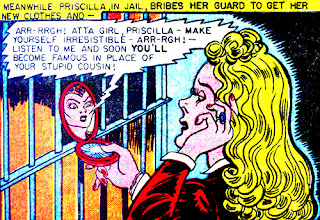Warlord #88 (December 1984)
Written by Cary Burkett; Penciled by Dan Jurgens; Inked by Rich Buckler.
Synopsis: In the port city of Bakwele, Scarhart and Morgan are seeking provisions, but wind up getting into a fight when a soldier insists Scarhart take the place of an injured slave bearing the governor’s litter. Outnumbered, our heroes try to escape into back alleys, but are blocked by a dead end.

Only briefly stymied, they escape across the rooftops after Scarhart knocks a chimney down on their pursuers. Morgan’s impressed:
Meanwhile, hundreds of leagues away, beneath the Great Fire Mountain, Tinder and his new buddy Chaka discover ancient chambers full of treasure and decorated with the sinister image of someone familiar to readers of this saga…
In Bakwele, Morgan and Scarhart seek a contact in the black market, Patch, recommended to them by Cap’n Hawk. Asking around in a tavern only gets them in another brawl, as they're mistaken for Atlantean spies. Our heroes are saved by the appearance of Patch, who throws a mean knife:

Patch takes them back to her home to talk. They meet her young son, Avenel, who excitedly tells them that a leader is coming to free them from Atlantean tyranny—a rider came through proclaiming it. Morgan gets excited too, and asks what this leader’s name is.
His hope dies when the boy tells him that the man is called “the Warlord.” He realizes the boy must have met Aton when he was Morgan’s herald, proclaiming the army of liberation. But all that ended. Aton died at Deimos’s hand and the army of ex-gladiators became bandits.
Morgan can’t hide his tears from the boy; he quickly changes the subject, though, and gets back to business. Soon, they’re sneaking down to the docks, so that Patch’s men can smuggle provisions onto the boats from the Wind Shadow. The plan hits a snag when they're discovered by Atlantean troops.
They manage to escape—all except Avenel. The boy is in Atlantean hands and on his way to interrogation!
Things to Notice:
- The Atlantean troops in Bakwele eschew the usual horned helmets we've seen before for capes. Maybe these are just collaborators?
- The Evil One was pretty full of himself. His treasure room has pictures of his diabolic mug all over the walls.
Where It Comes From:
This issue goes back to the recurrent Warlord theme of Travis Morgan having a noble goal, but failing to follow through. It also hints that he's starting to be mythologized a bit: Aton's visit was well before the Atlantean invasion, but Avenel assumes the two are related.
The Evil One was last seen (and defeated) by a Travis and Jennifer Morgan and friends in issue #66. He was turned back to his original form, the Gollum-esque Craetur in that issue.
This issue goes back to the recurrent Warlord theme of Travis Morgan having a noble goal, but failing to follow through. It also hints that he's starting to be mythologized a bit: Aton's visit was well before the Atlantean invasion, but Avenel assumes the two are related.
The Evil One was last seen (and defeated) by a Travis and Jennifer Morgan and friends in issue #66. He was turned back to his original form, the Gollum-esque Craetur in that issue.



















































.jpg)





